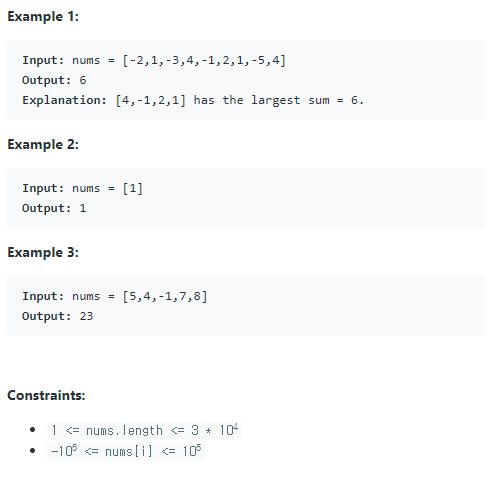
LeetCode Maximum_Subarray
2021, Mar 09
문제
- Given an integer array nums, find the contiguous subarray (containing at least one number) which has the largest sum and return its sum.

내가 푼 알고리즘.
- 항상 위와 같은 문제를 보면 모든 배열을 탐색해서 더해보는 방법이 제일 먼저 떠오른다. 더 나은 방법이 있겠지만.. 우선은 실전이다 생각하고 제일 빠르게 생각난 방법으로 문제를 풀어보았다.
- 인텔리제이에서 문제를 풀고, 옮겨서 테스트를 해보는 방식으로 진행했다.
int[] nums = {-2, 1, -3, 4, -1, 2, 1, -5, 4};
int answer = -2147483648; //int의 최소값
if (nums.length == 1){
return nums[0];
}
for(int i = 0 ; i < nums.length ; i++){
int temp = 0;
for(int j = i ; j < nums.length ; j ++){
temp = temp + nums[j];
if(answer < temp){
answer = temp;
}
}
}
- 위의 코드로 문제를 풀어내면..풀리기야 하겠지만..속도가 느리다 .
- 이유는 최악의 경우 전체 경우의 수를 전부 탐색하기 때문이다.
- Runtime: 98 ms, faster than 6.94% of Java online submissions for Maximum Subarray.
- Memory Usage: 38.9 MB, less than 58.18% of Java online submissions for Maximum Subarray.
- 속도가 느리다는 것을 알 수 있다.
참고한 알고리즘.
int currentSum = nums[0];
int maxSum = nums[0];
for(int i=1; i<nums.length; i++) {
currentSum = Math.max(nums[i]+currentSum, nums[i]);
maxSum = Math.max(currentSum, maxSum);
}
return maxSum;
- 참고한 코드로 문제를 돌려보면 for문을 1회 실행하기 때문에 시간복잡도는 O(n)이 됨을 알 수 있다. 크…
- Runtime: 0 ms, faster than 100.00% of Java online submissions for Maximum Subarray.
- Memory Usage: 38.6 MB, less than 91.05% of Java online submissions for Maximum Subarray.